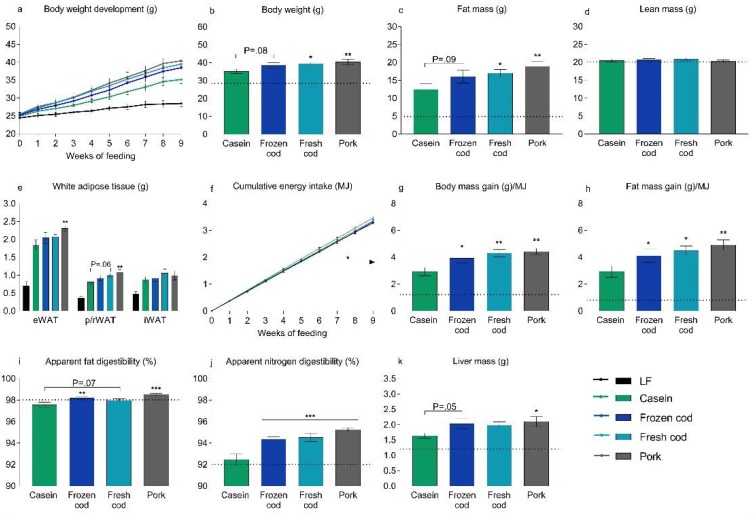Figure 1.
Effects of Western diets with different protein sources on body composition, energy intake and tissue weights. Male C57BL/6J mice were fed Western diets containing casein, frozen cod, fresh cod or pork as protein sources for 12 weeks. As a reference, a group of low fat (LF)-fed mice (n = 5) was also included and is shown as a dotted line. (a) Body weight development was measured and is shown for the first 9 weeks of feeding. (b) Body weight was measured and (c) fat mass and (d) lean mass were determined using nuclear magnetic resonance after 9 weeks of feeding. (e) Epididymal white adipose tissue (eWAT), inguinal white adipose tissue (iWAT) and perirenal/retroperitoneal white adipose tissue (p/r WAT) were dissected out after 12 weeks of feeding, and their masses were recorded; (f) Feed intake was recorded continuously, and cumulative energy intake (MJ) was determined and is shown for the first 9 weeks of feeding. The arrow indicates a significantly (p < 0.05) decreased energy intake in mice fed frozen cod and fresh cod compared to mice fed casein. (g) After 9 weeks of feeding, body mass gained per energy unit consumed and (h) fat mass gained per energy unit consumed were calculated; Apparent (i) fat and (j) nitrogen digestibility (%) were calculated based on feed intake and feces collected in the 6th week of feeding. (k) Livers were dissected out and weighed after 12 weeks of feeding. Data are presented as means ± SEMs (n = 10) and were analyzed using one-way ANOVA followed by Fisher’s LSD post hoc tests. Cumulative energy intake was analyzed by repeated measures ANOVA and Fisher’s LSD post hoc tests. *, ** and *** represent significant different from the Western diet containing casein at p < 0.05, p < 0.01 and p < 0.001 levels, respectively.

